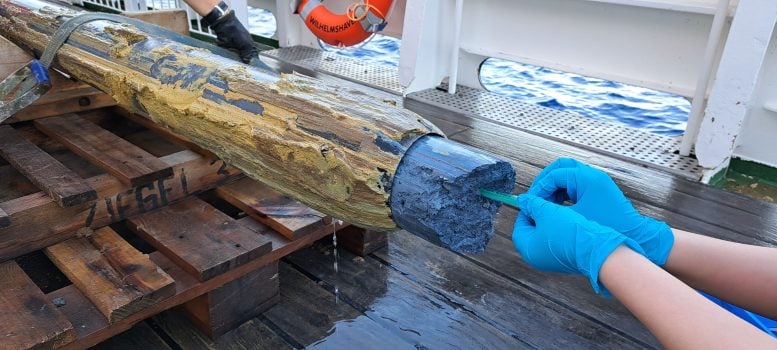Blocks of ice can behave truly strangely. On some surfaces, melting ice needs no outside push to skate — or even seemingly slingshot itself around. How truly ghostly!
The finding comes from a simple experiment. Its inspiration was the Racetrack Playa mystery in Death Valley, Calif. There, boulders weighing as much as 16.6 kilograms (36.6 pounds) seemingly dragged themselves hundreds of meters (yards) across a flat, dry lakebed.
 Just like these mysterious boulders that dragged themselves across Death Valley, ice chunks in a lab can move all by themselves too, scientists have now found.Buena Vista Images/Photodisc/Getty Images
Just like these mysterious boulders that dragged themselves across Death Valley, ice chunks in a lab can move all by themselves too, scientists have now found.Buena Vista Images/Photodisc/Getty Images
In 2014, scientists traced the rocks’ travels to rain freezing beneath the stones. When it melted, light breezes sent windowpane-thick sheets of ice sailing along atop their own meltwater. These toted the rocks with them. Some rocks sailed along at rates of 2 to 5 meters (6.6 to 16.4 feet) per minute!
Researchers at Virginia Tech in Blacksburg wondered whether they could design a surface to achieve this same effect without wind.
The surface they’ve now engineered not only makes this possible, but also allows ice chunks to slingshot themselves at speeds much faster than the Death Valley boulders.
This was “a shocker,” says Jonathan Boreyko. “I was not expecting [it] at all.”
A mechanical engineer, Boreyko led the work. He and his colleagues debuted their new surface August 27 in ACS Applied Materials & Interfaces. This cool science might one day be used to de-ice vehicles or generate electricity.
Playing around
Boreyko has a long history of looking into wacky water phenomena.
He’s studied how to keep frost from forming on scientific instruments in very cold environments. His lab also has studied the Leidenfrost effect. That’s where a droplet of water levitates on its own vapor in a super-hot environment. (You can observe this effect right now — with supervision! Just sprinkle a few drops of water on a very hot frying pan and watch the droplets dance.)
The Virginia Tech team wasn’t expecting much when it first started investigating whether ice could self-propel. They had thought “let’s just be kids at heart and play around,” Boreyko recalls. Then they’d “see what happens.”
 What started as a fun side project turned into a surprising discovery. Researchers at Virginia Tech engineered a surface across which ice will slingshot itself — no outside force needed. Photo by Alex Parrish for Virginia Tech
What started as a fun side project turned into a surprising discovery. Researchers at Virginia Tech engineered a surface across which ice will slingshot itself — no outside force needed. Photo by Alex Parrish for Virginia Tech
To create a mini racetrack for small sheets of ice, they cut angled grooves into a piece of aluminum. The grooves looked like a series of arrow-shaped channels. Known as a herringbone pattern, it helped guide water from the melting ice to flow in one direction.
Just as predicted, that meltwater ferried the remaining ice. “Picture a person tubing on a lazy river,” Boreyko says. “You have the ice melting.” And what hasn’t melted “just kind of goes along for the ride.” It slides along “very slowly and methodically.”
Speed skating
The team then made a second version of the surface. They coated this one with a waterproof spray. And it was this one that really surprised them.
They expected the ice to move across it a bit faster, says Boreyko. Instead, it lagged at first. Sometimes, it took almost half a minute to start moving. But then it suddenly accelerated — almost like a slingshot. The ice sailed across this surface 10 times faster than in the first experiment.
 After coating a grooved surface with a waterproofing spray, scientists found that small ice chunks would start moving slowly, then speedily propel themselves — despite no outside push.J.T. Tapocik et al/ACS Applied Materials & Interfaces 2025 (CC-BY 4.0)
After coating a grooved surface with a waterproofing spray, scientists found that small ice chunks would start moving slowly, then speedily propel themselves — despite no outside push.J.T. Tapocik et al/ACS Applied Materials & Interfaces 2025 (CC-BY 4.0)
A closer look revealed that this slingshot effect came from a difference in pressure at the front and back of the ice. At the front, meltwater spilled out in a flat puddle. Water couldn’t flow out as easily at the back. So the meltwater built up there.
This “creates a giant mismatch in surface tension that keeps building and building. Kind of like how your hand keeps pulling back more and more on the slingshot,” Boreyko explains. “Finally, that force is so dramatic that it unsticks the ice from the surface and slingshots it across.”
Making moving ice useful
The slingshot effect may be flashy. But it could prove “difficult to scale up,” says Dan Daniel, an applied physicist. It also “lacks long-term durability,” he adds. Daniel works at the Okinawa Institute of Science and Technology in Japan. What he finds most interesting about the new work is that the herringbone pattern alone can create and guide movement.
“The fact that propulsion can be driven simply by geometric structuring — without the need for specialized surface treatments — is a key strength of the paper,” he says.
Let’s learn about the weird science of ice
Xuehua Zhang is a materials engineer in Canada at the University of Alberta in Edmonton. She can imagine several potential uses for the slick discovery. One idea: Developing new ways to de-ice surfaces. “I even think it may be possible to convert the kinetic energy of the ice block to other forms of energy,” she says. “For example, electricity.”
Boreyko had that idea as well. Instead of going in a straight line, he imagines an ice chunk moving in a circle to rotate a turbine. But that idea is on the back burner for now. His lab is currently looking into how the slingshot effect might be used to sweep ice off surfaces such as car windshields.
What started as a “fun side project” now has the potential to make a serious impact, Boreyko says. This goes to show that you never know where your curiosity might take you.













 Bengali (Bangladesh) ·
Bengali (Bangladesh) ·  English (United States) ·
English (United States) ·